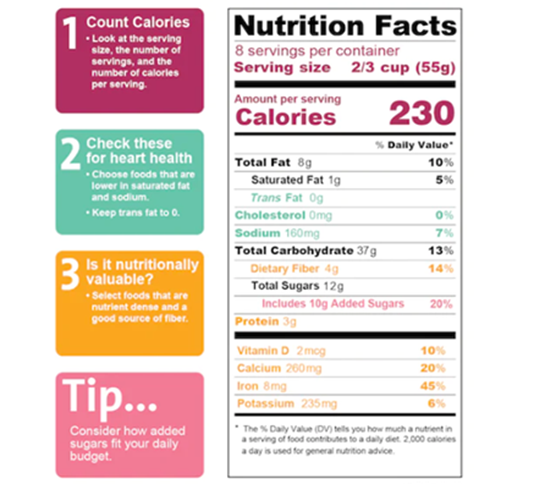Understanding the Nutrition Label

Two of the most important factors in maintaining a healthy diet are consuming proper portions and meeting the body’s nutritional demands. One of the easiest ways to ensure you are getting everything you need to fuel your body is by reading the nutrition label found on the back of food packages. These labels include all of the ingredients in the food as well as a lot of other helpful information to help you keep track of your nutritional wellness.
Below is a breakdown of everything a food label has to offer.
Serving Size
The first thing you’ll see on the food label is the serving size. The serving size will typically be marked in a standard cooking measurement like cups or grams. Checking the serving size before plating your food allows you to keep track of your portions.
In the example above, the product has a serving size of 2/3 cup, so the statistics listed below apply to that one serving. If you were to eat the entire package, you would have consumed eight servings.
Nutrients per Serving
The largest section on a food label will almost always be the calories and nutrient count. The label will include the three macronutrients (carbohydrates, fats and proteins), their sub-divisions and the most prominent micronutrients.
Immediately to the right of each category will be the measurement of that nutrient and a percentage number. Remember: This is information is based on serving size. If you eat two servings of the food, you have to multiply the grams of the nutrient by two.
The percentage represents the percentage of the recommended total daily intake for this nutrient. However, it is important to consider that these percentages are often based on a 2,000-calorie diet, so they may not be accurate for you and your dietary needs. An important reference to remember is that 5% or less is considered low and 20% or higher is considered high for daily value.
Like the graphic above displays, you want to be mindful of saturated fat, cholesterol, sodium, trans fat and added sugar. You also want to make sure you’re getting enough dietary fiber, vitamins and minerals.
Ingredients List
Typically, the last thing you will find on a food label will be the ingredients list. This is as simple as it sounds, identifying exactly what products were used to make the food. It can be an important area for those with allergies or a restricted diet.
The ingredients are listed in descending order by weight. For example, if dates are listed first in the list, they are the main ingredient in that product. Generally, the highest quality foods contain fewer ingredients, and these ingredients are unprocessed and easy to read and understand.
Understanding nutrition labels is an integral part of leading an overall healthy lifestyle. Now that you understand how to decode them, use this knowledge to your advantage!

